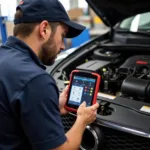OBD2 code writing is a complex process that involves understanding vehicle systems, diagnostic protocols, and the ability to translate this knowledge into a standardized format that can be interpreted by OBD2 scanners. While the average car owner may never need to write their own OBD2 codes, gaining a deeper understanding of how these codes are created can provide valuable insights into vehicle diagnostics and troubleshooting.
What is OBD2 Code Writing?
At its core, OBD2 code writing is the process of assigning specific alphanumeric codes to represent various vehicle malfunctions detected by the On-Board Diagnostics system. These codes, often referred to as Diagnostic Trouble Codes (DTCs), serve as a universal language for mechanics and technicians, allowing them to quickly identify the nature and location of potential problems within a vehicle’s engine, transmission, emissions system, or other critical components.
The Importance of Standardized OBD2 Codes
Prior to the widespread adoption of OBD2 standards in the mid-1990s, each vehicle manufacturer had its own proprietary system for diagnosing problems. This lack of standardization created a significant challenge for mechanics, who often needed specialized equipment and knowledge to work on different makes and models. The introduction of standardized OBD2 codes revolutionized the automotive repair industry by providing a common language for all vehicles sold in the United States and many other parts of the world. This standardization has led to faster and more accurate diagnoses, reduced repair costs, and improved overall vehicle safety.
The Role of the Society of Automotive Engineers (SAE)
The standardization of OBD2 codes is largely attributed to the Society of Automotive Engineers (SAE), a global organization of engineers and technical experts in the aerospace, automotive, and commercial vehicle industries. The SAE developed and published the J2012 standard, which outlines the specific format and definitions for all OBD2 codes. This standard ensures consistency and interoperability across different vehicle manufacturers and diagnostic tools.
The Process of OBD2 Code Writing
Developing new OBD2 codes is a meticulous process that involves collaboration between automotive engineers, software developers, and regulatory bodies. The process typically begins with identifying a specific vehicle malfunction that needs to be detected and reported by the OBD2 system.
Once a malfunction is identified, engineers develop diagnostic procedures and algorithms that can reliably detect the problem. This often involves analyzing sensor data, monitoring system performance, and conducting extensive testing under various operating conditions.
After the diagnostic procedures are finalized, a unique OBD2 code is assigned to the specific malfunction. This code is then incorporated into the vehicle’s Engine Control Unit (ECU) software, which is responsible for monitoring the various systems and triggering the check engine light when a fault is detected.
The Future of OBD2 Code Writing
As vehicles become increasingly sophisticated with advanced driver-assistance systems (ADAS) and electric powertrains, the landscape of OBD2 code writing continues to evolve.
The increasing complexity of vehicle systems necessitates the development of new codes and diagnostic procedures to address emerging technologies and potential malfunctions. Additionally, the rise of connected and autonomous vehicles presents new opportunities for leveraging OBD2 data for remote diagnostics, predictive maintenance, and enhanced vehicle safety features.
Conclusion
While OBD2 code writing may seem like a niche topic reserved for automotive engineers, understanding the fundamentals of this process can be beneficial for anyone interested in vehicle diagnostics and repair. By comprehending how these codes are created, standardized, and implemented, car owners and enthusiasts can gain a deeper appreciation for the complexity of modern vehicles and the critical role that OBD2 systems play in ensuring their safe and efficient operation.


